Gen Z: Cover Crop Demo’s
Season results and findings
The benefits of establishing a cover crop in the vineyard work row have been well documented and include increased soil organic matter, improved soil structure, enhanced microbial activity, reduced surface crusting, better water infiltration and weed suppression in some cases. While drawbacks such as the cost of seed, increased susceptibility to frost and risk of fires, the likelihood of competition with grapevines and the attraction of pests are valid concerns, these seem to be outweighed by the numerous advantages despite many being unquantifiable in terms of rand value. Ultimately choosing to sow cover crops is a form of playing the long game in the goal towards achieving a more sustainable, diverse and resilient farming system.
The establishment of cover crops, their interaction with soil microorganisms, grapevine roots and insects as well as their response to climatic conditions remains a complex subject, requiring a great deal more scientific research, as well as experimentation by producers. Ascertaining what covers or mixtures are suitable to one’s farming system, soil type and climate, necessitates a bit of trial and error. The need for localised information that is beneficial to a broad range of producers is one of the major reasons for the initiation of the cover crop demos under the Gen-Z Vineyard Project. The cover crop demos are not scientific experiments, but are rather field trials set up to demonstrate to producers what works and what doesn’t under a particular set of conditions. Furthermore the demos serve to inform producers about new species and mixtures on the market.
Producers during the Grower Days at the Cavalli demo sites in 2019
Producers during Grower Days at Cavalli demo sites in 2019.
Region: Coastal
Region: Breede River Valley
Region: Cape South coast
Three Grower Demos days where held, in collaboration with Agricol and Barenbrug in October at three different cover crop demo sites. A total of 65 growers, vineyard managers and viticulturists attended these Grower Days which took place in Robertson, Rawsonville and Stellenbosch. During these interactive sessions producers discussed physical results, findings and insights.
The 2022 cover crop year was a challenging one in terms of climatic conditions. Throughout all of the sites reported on below we had less rainfall and slightly higher temperatures throughout the cover crop growing season. This had a negative effect on germination and caused some sites to be less successful in supressing weeds than in previous years. Generally, the DMP (dry mass production) was less than previous years which shows that the growth was not as successful due to sub-optimum growing conditions.
Five Grower Demo Days were held in October 2021 at Gen-Z cover crop demo sites which were established in collaboration with enthusiastic growers and seed suppliers, Barenbrug and Agricol. A total of 68 growers, vineyard managers and viticulturists attended these Grower Days which took place in Robertson, Breedekloof, Rawsonville and Stellenbosch. Apart from demonstrating the performance of a variety of mixtures under a particular set of conditions, the demos are aimed at providing an opportunity for participants to interact and share cover crop and other vineyard management-related experiences and insights.
Cover crops are a valuable tool in vineyard management systems and can make numerous agro-ecological contributions to a vineyard production system:
- Increase soil organic carbon (SOC) over time
- Aid in soil moisture retention and water infiltration
- Improve soil aggregate stability
- Limit run-off and erosion
- Suppress weeds
- Increase biodiversity
The Gen-Z Vineyard Project established eleven cover crop demos in total in April-May 2021, in collaboration with Agricol and Barenbrug. Seed for the seven demos reported on below was supplied by Barenbrug and mix recommendations provided by Ivan Jansen van Rensburg (Barenbrug). A sample area of each plot was harvested and the mix components separately weighed, as well as the weeds harvested in the sample area. The components were then oven-dried and re-weighed. The below data is generated from a field trial and not a scientific experiment. The data below provides an indication of the total biomass produced in each plot as well as the individual components within the plots.
The correct choice of cover crop or mix and management thereof is site specific and requires some small-scale experimentation on the part of the grower. By exposing growers to a variety of cover crop mixtures on different soils, the Gen-Z Vineyard Project hopes to assist with refined decision-making on the part of growers when implementing cover crops in their own vineyards. Whether sowing a mix or a single species, cover crops have potential to make a significant contribution to soil organic carbon in our vineyard ecosystems, the importance of which is well-documented.
Seed for the four demos reported on below was supplied by Agricol, as were the cover crop mix recommendations per site. Each demo consisted of eight treatments (mixes), which were sown in a full vineyard row at the sowing rate recommended by Agricol.
Region: Coastal
DISTRICT: STELLENBOSCH
Year: 2022
Demo Site: Welgevallen Experimental Training Vineyards
Soil description: Deep, loam, clay
Vineyard irrigation: Drip
Sowing date: Early May 2022
Sowing method: Sown by hand (Plot 2&3) and Planter (Plot 1)
Harvest: 29 September 2022
Rainfall (2022 vs 2021): 386mm vs 456,89mm
General climatatic conditions January – September (compared to long term average): Higher temperatures and below average rainfall in January, March and May, July and August. April was cooler but received below average rainfall. June received more rainfall than on average. September was cool with average rainfall.
| Plot | Variety/ Species | Type | Seeding rate (kg/ha) | DMP (t/ha) | Observations | Photos taken |
|---|---|---|---|---|---|---|
1 | US 2019 Triticale | Cereal | 100 | 13.1 | Good option for a cereal cover crop. The stand was good but not as tall as forage rye. Some ryegrass and ramenas present. Seed Cost: R994,00/ha |  |
Total mix | 100 | 13.1 |
||||
"Re-growth"/ "Opslag" | 0.0 |
|||||
Weeds | 0.2 |
|||||
2 | Barpower Forage rye | Cereal | 30 | 2.3 | Good combination, dense stand with good weed supression. The mustard was flowering and produced a very good stand. Forage rye performed well and produced a good stand. The grazing vetch was not successful. Ryegrass and ramenas was present in the work row. Seed Cost: R996,46/ha |  |
Haymaker Grazing Vetch | Legume | 6 | 0.0 |
|||
Scala Brown Mustard | Brassica | 1 | 6.6 |
|||
Total mix | 37 | 8.9 |
||||
"Re-growth"/ "Opslag" | ||||||
Weeds | 0.1 |
|||||
3 | Moby Forage Barley | Cereal | 30 | 3.7 | Less successful than the other mixes. The Forage barley produced a very good stand and was at the soft dough stage at harvest time. The peas grew successfully but the radish had variable success. Quite a lot of Forage rye came up from the previous season. Some ryegrass present in the work row. Seed Cost: R762,51/ha |  |
Arvika Forage Peas | Legume | 15 | 0.7 |
|||
Cordoba Radish | Brassica | 1.5 | 0.8 |
|||
Total mix | 46.5 | 5.3 |
||||
"Re-growth"/ "Opslag" | 6.8 |
|||||
Weeds | 0.1 |
District: Stellenbosch
Year: 2021
Demo Site: Kanonkop
Soil description: Deep, well-drained, loam-clay
Vineyard irrigation: Drip
Sowing date: Early May 2021
Sowing method: By hand
Harvest: Late September 2021
| Plot | Variety/Species | Type | Seeding rate (kg/ha) | DMP (t/ha) | Observations | Photos taken |
|---|---|---|---|---|---|---|
1 | Barsaia Saia Oats | Cereal | 30 | 6.6 | Although the oats was not yet in seed, this mix performed the best overall at this site. The fodder radish made up a small portion of the seed mix and was average to poor in its growth. The weed suppression was excellent. Seed Cost: R780/ha |  |
Tajuna Fodder Radish | Brassica | 3 | 0.6 |
|||
Total mix | 33 | 7.2 |
||||
Weeds | 0.0 |
|||||
2 | Barpower Forage rye | Cereal | 30 | 5.2 | The forage rye performed well while the grazing vetch and brown mustard were average in their performance. Weed suppression of this mix was very good. Seed Cost: R950/ha |  |
Haymaker Grazing Vetch | Legume | 6 | 0.7 |
|||
Scala Brown Mustard | Brassica | 1 | 0.4 |
|||
Total mix | 37 | 6.2 |
||||
Weeds | 0.0 |
|||||
Re-growth/ "Opslag" | 0.0 |
|||||
3 | Moby Forage Barley | Cereal | 30 | 4.4 | The forage barley in this plot dominated the mixture and yielded good biomass. The phacelia and forage pea performance was average. This mix produced the lower DM of the three mixes but weed suppression was still very effective. There was quite a bit of growth of the previous season’s cover crops (opslag). Seed Cost: R935/ha |  |
Stala Phacelia | Forb | 2 | 0.4 |
|||
Arvika Forage Peas | Legume | 20 | 0.2 |
|||
Total mix | 52 | 5.0 |
||||
Weeds | 0.0 |
|||||
Re-growth/ "Opslag" | 1.8 |
District: Stellenbosch
Year: 2021
Demo Site: Welgevallen Experimental Training Vineyards
Soil description: Deep, loam, clay
Vineyard irrigation: Drip
Sowing date: Early May 2021
Sowing method: Sown by hand (Plot 1&2) and Planter (Plot 3)
Harvest: Late September 2021
This vineyard block was established in 2020 and therefore the soil had relatively little compaction in the work row which would have contributed to the above-average performance of the cover crops in this block. All three mixes produced impressive stands and suppressed weeds effectively. The stands, when rolled using a crimp roller, created a protective mat over the soil that lasted for several months.
| Plot | Variety/ Species | Type | Seeding rate (kg/ha) | DMP (t/ha) | Observations | Photos taken |
|---|---|---|---|---|---|---|
1 | Barpower Forage rye | Cereal | 35 | 7.4 | Excellent stand and biomass production as seen in the 9t/ha DM. Brown mustard and vetch were outcompeted by the forage rye. Outstanding weed suppression. Seed Cost: R1030/ha |  |
Haymaker Grazing Vetch | Legume | 6 | 0.1 |
|||
Scala Brown Mustard | Brassica | 1 | 1.4 |
|||
Total mix | 42 | 9.0 |
||||
Weeds | 0.0 |
|||||
2 | Moby Forage Barley | Cereal | 30 | 7.0 | Although not as tall a stand as mixture 1, this mixture produced 9t/ha dry matter which was largely due to the robust barley growth. The fact that the barley was in the soft dough stage contributed to the high biomass weighed. The forage peas produced just under 1.7t/ha DM whereas the fodder radish was variable in growth. Weed suppression was excellent. Seed Cost: R885/ha | 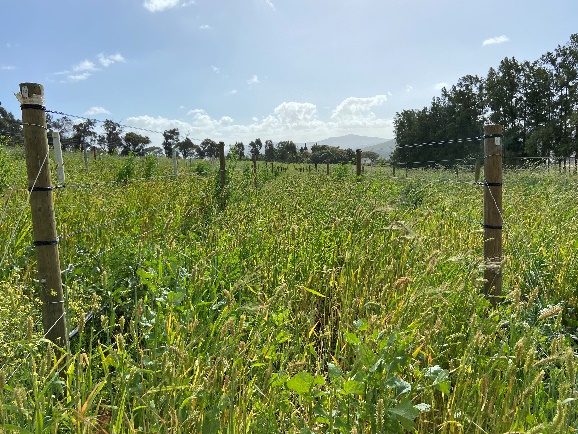 |
Arvika Forage Peas | Legume | 20 | 1.7 |
|||
Tajuna Fodder Radish | Brassica | 2 | 0.4 |
|||
Total mix | 52 | 9 |
||||
Weeds | 0 |
|||||
3 | US 2014 Triticale | Cereal | 140 | 10.6 | The Triticale, US 2014, produced the highest biomass at 10.5t/ha and excellent weed suppression. The soft dough stage at the time of harvesting and the fact that it did not have other varieties with which to compete, likely played a role in the very high DMP. Seed Cost: R1165/ha | 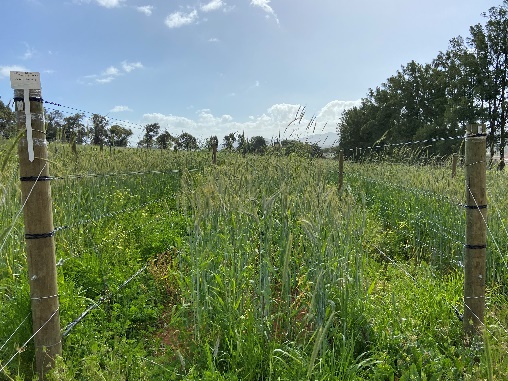 |
Weeds | 0.0 |
*DM = Dry Matter Production (Tons/Hectare)
District: Stellenbosch
Year: 2020
Demo Site: Cavalli
Soil description: Sandy loam
Vineyard irrigation: Drip
Sowing date: Early May
Sowing method: By hand
The suitability of the mixes to this site was largely favourable with most of the mixes performing well, despite not receiving any fertiliser. The rye with
bitter lupins produced the largest biomass of the eight mixes, but mixes 4, 5 and 7 were not far behind.
| Row | Product mix & species | Recommended sowing rate & seed cost | Comments | Photos taken: Late September 2020 |
|---|---|---|---|---|
| 1 | Hexvallei mix with rye Rye, Oats (Magnifico), Ripper radish (Groundhog), Japanese radish (Nooitgedacht), Common vetch (Timok) | 30 kg/ha R594/ha | Stand height: Medium Stand density: Good Weed suppression: Good |  |
| 2 | Rye (Duiker max), Bitter lupins (SSL 10) | 40 kg/ha R600/ha | Stand height: Medium Stand density: Very good Weed suppression: Very good Rye did reasonably well, while the lupins created effective competition for weeds. |  |
| 3 | Agrilife 2 Stooling rye (Macblue), Oats (Magnifico), Ripper radish (Groundhog), Japanese radish (Nooitgedacht), Common vetch (Timok) | 30 kg/ha R950/ha | Stand height: Low to medium Stand density: Very good Weed suppression: Excellent The oats together with the radish and vetch created a dense stand. Stooling rye prefers lighter sandy soils. |  |
| 4 | Mooigezight mix Polymorpha medic (Cavalier), Barrel medic (Paraggio), Subterranean clover (Dalkeith), Balansa clover (Paradana), Bitter lupins (SSL 10) | 30 kg/ha R850/ha | Stand height: Low Stand density: Very good Weed suppression: Very good Dense, low-growing stand or cover. |  |
| 5 | Goudini mix with triticale Triticale (AG Beacon), Oats (Magnifico), Ripper radish (Groundhog), Japanese radish (Nooitgedacht), White mustard (Braco) | 30 kg/ha R594/ha | Stand height: Medium Stand density: Good Weed suppression: Good to very good Triticale and oats established early and appeared to overshadow the radish and white mustard. |  |
| 6 | Goudini mix with barley Barley (SKG 9), Oats (Magnifico), Ripper radish (Groundhog), Japanese radish (Nooitgedacht), White mustard (Braco) | 30 kg/ha R594/ha | Stand height: Medium to high Stand density: Very good Weed suppression: Very good The oats and barley performed quite well compared to the radish and white mustard, possibly an overshadowing effect. |  |
| 7 | Vlottenburg mix Triticale (AG Beacon), Oats (Magnifico), Ripper radish (Groundhog), Japanese radish (Nooitgedacht), Common vetch (Timok), Crimson clover (Blaza), Bitter lupins (SSL 10), White mustard (Braco) | 30 kg/ha R650/ha | Stand height: Medium Stand density: Very good Weed suppression: Excellent |  |
| 8 | Swartland medic mix Polymorpha medic (Cavalier), Barrel medic (Parabinga), Button medic (Bindaroo), Subterranean clover (Dalkeith), Balansa clover (Paradana) | 12 kg/ha R1 200/ha | Stand height: Low Stand density: Average to good Suitable for establishment on grapevine row to provide ground cover and suppress weeds. |  |
District: Stellenbosch
Year: 2019
Demo Site: Kanonkop, Simonsberg
Soil Description: High potential Oakleaf
Sowing Date: Early May 2019
The mixture of white mustard and forage rye produced excellent biomass on this soil type and performed somewhat better than the mixture of forage oats, triticale and forage peas. The rye produced good biomass, while the triticale was average in terms of biomass production. The mixture of oats and stooling rye worked well with the stooling rye producing notable biomass. The phacelia and radish were patchy where these species had been sown by hand, as was the faba bean cover (one of the challenges of small scale field trials). Where these cover crops had been sown in another section of the block using the planter, results were far better with even, dense growth.
Where the phacelia was sewn using the planter, it produced an excellent stand with purple flowers which attracted many bees. The medics which had been sewn by hand on the grapevine row underneath the drippers, was a huge success at this site. Although medics is not aggressive in its growth habit, it did reach just below the cordon wire at various points in the block. This required a team to walk through the block and trample the medics flat on one occasion early in the season. At the time of evaluation, the medics was nearing the end of its life cycle and would be expected to set seed and die off by the end of spring.
| Treatment | Recommended Sowing Rate kg/ha | Performance | Approximate Seed Cost R/ha | Photos taken |
|---|---|---|---|---|
| White mustard + forage rye | 3 + 30 | Very good/Excellent | 675 | |
| Forage oats + triticale + forage peas | 20 + 40 + 15 | Good/Very good | 800 |  |
| Rye | 45 | Good | 675 | |
| Triticale (2 species) | 100 | Average | 800 | |
| Phacelia | 7 | Average (by hand) Excellent (planter) | 805 |  |
| Premix: oats (3 species) and stooling rye | 40 | Very good | 693 | |
| Forage radish and vetch | 2+10 | Good | 600 | |
| Faba beans | 80 | Average (by hand) Very good (planter) | 950 | |
| Medics (on the bankie) | 5 | Excellent | 495 |  |
District: Stellenbosch
Year: 2019
Demo Site: Cavalli, Helderberg
Soil Description: Granite-based duplex
Sowing Date: Late April 2019
Cover crops at the Helderberg site produced good biomass in general. The forage barley and pea mixture produced reasonably high biomass. The forage rye produced a higher biomass than the forage barley. Forage rye has a longer growing season than forage barley, which should be taken into consideration when selecting a cover crop species to suit planned sewing and termination dates. The forage radish, triticale and vetch mixture yielded good biomass, although the radish produced a small bulb. The bitter lupine and vetch mixture produced high biomass, and provided good weed suppression. The oats, radish and vetch mixture produced a low but dense stand with good biomass and good weed suppression. The triticale stand was average as was its weed suppression. The rye produced a taller stand with better weed suppression. The phacelia, a later-growing species, produced a good stand with medium to high biomass, excellent weed suppression and purple flowers in first two weeks of October.
| Treatment | Recommended Sowing Rate kg/ha | Performance | Approximate Seed Cost R/ha | Photos taken |
|---|---|---|---|---|
| Forage barley + forage peas | 35 +25 | Good/Very good | 700 | |
| Forage rye | 45 | Very good | 680 | 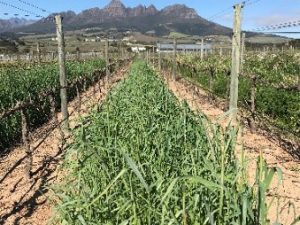 |
| Forage radish + triticale + vetch | 1.5 + 40 + 6 | Good | 680 | |
| Pre-mix: Oats + stooling rye + radish + tiller radish + vetch | 30 | Excellent | 950 |  |
| Rye | 45 | Very good | 675 |  |
| Bitter lupins + vetch | 35 + 8 | Excellent | 532 | |
| Triticale | 100 | Average | 750 | |
| Phacelia | 7 | Good | 805 |
DISTRICT: PAARL
District: Paarl
Year: 2022
Demo Site: Klipvlei
Soil description: Heavy clay
Vineyard irrigation: Drip
Sowing date: Early May
Sowing method: Planter
Harvested: 28 September 2022
Rainfall (2022 vs 4 year average): 408,8mm vs 526,42mm
General climatatic conditions January – September (compared to long term average): January – May had higher temperatures with below average rainfall. June to September had mild temperatures with below average rainfall.
| Plot | Variety/Species | Type | Seeding rate (kg/ha) | DMP (t/ha) | Observations | Photos taken |
|---|---|---|---|---|---|---|
1 | Moby Forage Barley | Cereal | 30 | 1.9 | The barley performed well and was just pass soft dough stage at harvest. The white mustard and the forage peas did not perform well and was supressed by other components. Large amounts of ryegrass grew in the work row. Regrowth of saia oats and forage rye from the previous season. Seed Cost: R704,28/ha |  |
Venice White Mustard | Brassica | 1.5 | 0.3 |
|||
Arvika Forage Peas | Legume | 15 | 0.0 |
|||
Total mix | 46.5 | 2.3 |
||||
Weeds | 0.8 |
|||||
Re-growth/ "Opslag" | 0.5 |
|||||
2 | Barsaia Saia Oats | Cereal | 25 | 0.3 | This mixture had poor weed supression even though the vetch performed quite well. Saia oats had very patchy growth with a weak stand. Ryegrass was prominent in the work row. Some forage rye came up as re-growth from the previous season. Seed Cost: R836,29/ha |  |
Haymaker Grazing Vetch | Legume | 7 | 0.7 |
|||
Total mix | 32 | 0.9 |
||||
Weeds | 0.5 |
|||||
Re-growth/ "Opslag" | 1.4 |
|||||
3 | Barpower Forage rye | Cereal | 30 | 2.0 | Excellent weed supression even though the stand was not extremely dense. The forage rye was very successful and produced the mayority of the total mix mass. The radish was not successful and the lupins had inconsistent growth. Forage barley was present from the previous season. Seed Cost: R863,31/ha |  |
Cordoba Radish | Brassica | 1.5 | 0.0 |
|||
Azuro Bitter Lupines | Legume | 15 | 0.1 |
|||
Total mix | 46.5 | 2.2 |
||||
Weeds | 0.0 |
|||||
Re-growth/ "Opslag" | 2.0 |
*DM = Dry Matter Production (Tons/Hectare)
District: Paarl
Year: 2021
Demo Site: Klipvlei
Soil description: Heavy clay
Vineyard irrigation: Drip
Sowing date: May
Sowing method: Planter
Harvested: Late August 2021
| Plot | Variety/Species | Type | Seeding rate (kg/ha) | DMP (t/ha) | Observations | Photos taken |
|---|---|---|---|---|---|---|
1 | Barsaia Saia Oats | Cereal | 25 | 1.4 | This mix did not perform well in 2021 due to high weed pressure and emergence of cereals from the previous season. The previous season this mix produced an excellent stand. Seed Cost: R795/ha |  |
Haymaker Grazing Vetch | Legume | 7 | 0.0 |
|||
Total mix | 32 | 1.4 |
||||
Weeds | 3.1 |
|||||
Re-growth/ "Opslag" | 3.0 |
|||||
2 | Barpower Forage rye | Cereal | 30 | 2.0 | Average performance of this mix this season compared to the previous season. Weed suppression was good. Seed Cost: R885/ha |  |
Tajuna Fodder Radish | Brassica | 2 | 1.4 |
|||
Azuro Bitter Lupines | Legume | 20 | 0.0 |
|||
Total mix | 52 | 3.5 |
||||
Weeds | 0.0 |
|||||
Re-growth/ "Opslag" | 0.0 |
|||||
3 | Moby Forage Barley | Cereal | 30 | 6.7 | This mix was the best performer at this site, producing over 8t/ha DM, largely due to the successful growth of the forage barley. The forage peas performed poorly. Weed suppression was excellent. Seed Cost: R830/ha |  |
Venice White Mustard | Brassica | 2 | 2.0 |
|||
Arvika Forage Peas | Legume | 20 | 0.1 |
|||
Total mix | 52 | 8.9 |
||||
Weeds | 0.0 |
|||||
Re-growth/ "Opslag" | 0.4 |
*DM = Dry Matter Production (Tons/Hectare)
District: Paarl
Year: 2020
Demo Site: Klipvlei
Soil description: Klapmuts, Cartref, Vilafontes, Genrosa, Oakleaf
Vineyard irrigation: Drip
Sowing date: Late April
Sowing method: Planter
The cereals, such as triticale, oats and barley, did remarkably well at this demo site, treatments 5 and 7 in particular. The inadequate growth of the lupins and peas was likely due to the sowing depth, which was deeper as a result of using a planter. Lupins and peas had previously performed well on this site and would be expected to grow well if sown at a suitable (shallow) depth.
| Row | Product mix & species | Recommended sowing rate & seed cost | Comments | Photos taken: Late September 2020 |
|---|---|---|---|---|
| 1 | Hexvallei mix Triticale (AG Beacon), Oats (Magnifico), Ripper radish (Groundhog), Japanese radish (Nooitgedacht), Common vetch (Timok) | 30 kg/ha R594/ha | Stand height: High Stand density: Very good Weed suppression: Excellent |  |
| 2 | Triticale (AG Beantly), Bitter lupins (SSL10) | 40 kg/ha R600/ha | Stand height: Very high Stand density: Very good Weed suppression: Very good Cereals performed excellently, while radish and white mustard growth was average. | 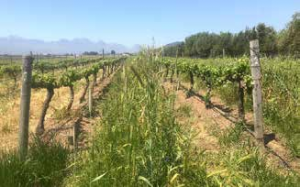 |
| 3 | Treatments 3 in this demo were slashed before images were captured. | |||
| 4 | Treatments 4 in this demo were slashed before images were captured. | |||
| 5 | Goudini mix with triticale Triticale (AG Beacon), Oats (Magnifico), Ripper radish (Groundhog), Japanese radish (Nooitgedacht), White mustard (Braco) | 30 kg/ha R594/ha | Stand height: Very high Stand density: Very good Weed suppression: Very good Cereals performed excellently, while radish and white mustard growth was average. |  |
| 6 | Goudini mix with barley Barley (SK9), Oats (Magnifico), Ripper radish (Groundhog), Japanese radish (Nooitgedacht), White mustard (Braco) | 30 kg/ha R594/ha | Stand height: High Stand density: Good Weed suppression: Average Radish and white mustard growth was average to poor. | 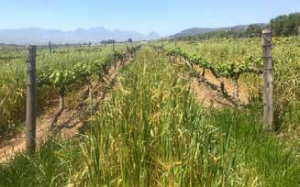 |
| 7 | Oats (Magnifico), Peas (Astronaut) | 40 kg/ha R600/ha | Stand height: High Stand density: Excellent Weed suppression: Excellent Performance of the peas was average, but the oats provided a dense, healthy stand. |  |
| 8 | Swartland medic mix Polymorpha medic (Cavalier), Barrel medic (Parabinga), Button medic (Bindaroo), Subterranean clover (Dalkeith), Balansa clover (Paradana) | 12 kg/ha R1 200/ha | Stand height: Low Stand density: Very good Weed suppression: Good |  |
DISTRICT: WELLINGTON
District: Wellington
Year: 2019
Demo Site: Olifantskop, Wellington
Soil Description: Weathered granite
Sowing Date: Mid-late April 2019
The mixtures of forage rye with peas and forage rye with bitter lupines were the best performers on this challenging soil type, providing good biomass and weed suppression. The rye, bitter lupines and vetch produced average biomass. The phacelia’s biomass was poor and the mixture comprised of three different oats species with stooling rye, performed reasonably well. The importance of top dressing was illustrated by the clear difference in the density and height of the stands between the ‘top-dressed’ and non-‘top-dressed’ treatments.
| Treatment | Recommended Sowing Rate kg/ha | Performance | Approximate Seed Cost R/ha | Photos taken |
|---|---|---|---|---|
| Forage rye + bitter lupins | 30 + 20 | Excellent | 650 |  |
| Forage rye + forage peas | 30 + 15 | Very good | 700 | |
| White mustard + oats + vetch | 1.5 + 20 + 6 | Good | 630 | |
| Rye | 45 | Average | 675 | |
| Bitter lupins + vetch | 40 + 8 | Good | 580 | |
| Triticale | 100 | Good | 750 | |
| Premix: oats (3 species) + stooling rye | 40 | Good | 693 | |
| Phacelia | 7 | Average | 805 |
DISTRICT: SWARTLAND
District: Swartland
Year: 2019
Demo Site: Vlakkenheuwel, Hermon
Soil Description: Well-weathered shale
Sowing Date: Mid-May 2019
All the mixtures performed well at this site. The forage rye in the forage rye and vetch mixture flourished and outperformed all the other cereals and species at this site. The white mustard produced very good stands with and without oats. The mixture of forage barley, forage peas and radish, which offers a good balance of biomass production, nitrogen fixation and bio tillage, produced good biomass and suppressed weeds. The mixture of oats, radish, stooling rye and vetch provided a dense stand with substantial biomass. The mixture of triticale and lupines also performed excellently. The phacelia produced moderate amount of biomass which was comparable to the phacelia growth at other sites in 2019. Although the medics and clover cover was recommended for application on the grapevine row, it grew extremely well in the work row at this site. It is recommended that medics be sown on the grapevine row to provide a good ground cover that is not expected to grow into the grapevine canopy.
| Treatment | Recommended Sowing Rate kg/ha | Performance | Approximate Seed Cost R/ha | Photos taken |
|---|---|---|---|---|
| Forage rye + vetch | 25 + 6 | Excellent | 670 |  |
| White mustard + Saia oats | 3.5 + 25 | Excellent | 570 |  |
| White mustard | 8 | Excellent | 592 | |
| Forage barley + forage pea + radish | 25 + 20 + 1.5 | Very good | 650 | |
| Oats + stooling rye + radish + vetch | 30 | Very good/Excellent | 950 |  |
| Bitter lupines + triticale | 25 + 60 | Excellent | 655 | |
| Phacelia | 7 | Average | 805 | |
| Medics + clover (on the bankie) | 3 + 2 | Excellent | 470 |  |
Region: Breede River Valley
DISTRICT: BREEDEKLOOF
District: Breedekloof
Year: 2022
Demo Site: Diepkloof
Soil Description: Heavy clay
Vineyard irrigation: Drip
Sowing Date: Middle May
Sowing method: By hand
Harvested: 3 October 2022
Rainfall (2022 vs 4 year average): 257,93mm vs 349,24mm
General climatatic conditions January – September (compared to long term average): January and February had below average rainfall with above average temperatures. March had higher temperatures. May had lower temperatures with above average rainfall. June was warmer than normal but had average rainfall. July, August and September was slightly warmer with below average rainfall.
| Plot | Variety/Species | Type | Seeding rate (kg/ha) | DMP (t/ha) | Observations | Observations |
|---|---|---|---|---|---|---|
1 | Barforce Silage Barley | Cereal | 30 | 1.2 | Great combination, was very successful in supressing weeds. The radish and barley performed well and produced a good stand. The peas did not perform as well and produced very little mass. No weeds were present. Saia oats came up from the previous season. Seed Cost: R730,71/ha | 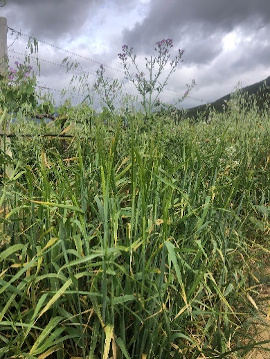 |
Arvika Forage Peas | Legume | 15 | 0.0 |
|||
Cordoba Radish | Brassica | 1.5 | 0.7 |
|||
Total mix | 46.5 | 1.9 |
||||
Weeds | 0.0 |
|||||
"Re-growth"/ "Opslag" | 3.4 |
|||||
2 | Barsaia Saia Oats | Cereal | 30 | 3.7 | Saia oats was very successful and seems to be a good choice for an oats cover crop. The brown mustard was patchy and not as successful. Some ryegrass present. Seed Cost: R724.31/ha |  |
Scala Brown Mustard | Brassica | 1.5 | 0.1 |
|||
Total mix | 31.5 | 3.8 |
||||
Weeds | 0.1 |
|||||
"Re-growth"/ "Opslag" | 0.0 |
|||||
3 | Barpower Forage rye | Cereal | 30 | 0.8 | The forage rye produced a good stand, but not as dense as saia oats. The vetch and white mustard was quite patchy and did not perform well. Ramenas and ryegrass was present. Saia oats came up from the previous season. Seed Cost: R940,94/ha |  |
Haymaker Grazing Vetch | Legume | 6 | 0.0 |
|||
Venice White Mustard | Brassica | 1 | 0.8 |
|||
Total mix | 37 | 1.6 |
||||
Weeds | 0.3 |
|||||
"Re-growth"/ "Opslag" | 1.6 |
*DM = Dry Matter Production (Tons/Hectare)
District: Breedekloof
Year: 2021
Demo Site: Diepkloof
Soil Description: Heavy clay
Vineyard irrigation: Drip
Sowing Date: Middle May
Sowing method: By hand
Harvested: Late September 2021
The difficult soil type was the reason for selecting this site. Good rainfall experienced in 2021 (550mm Jan-Sept 2021) and seedbed preparation are likely to have contributed to the success of the cover crops at this demo. The mixtures at this site produced good biomass on the whole. Interestingly the grower has achieved a relatively good stand and cover across the work row in the adjacent block where Prairie grass (Bromus), has been sown and encouraged. Although native to South America, this grass is now naturalised in many other locations.
| Plot | Variety/Species | Type | Seeding rate (kg/ha) | DMP (t/ha) | Observations | Observations |
|---|---|---|---|---|---|---|
1 | Barsaia Saia Oats | Cereal | 35 | 6.1 | This mixture performed the best out of the three in terms of biomass produced. The Saia oats performed very well while the brown mustard growth was patchy. Seed Cost: R810/ha |  |
Scala Brown Mustard | Brassica | 2 | 1.3 |
|||
Total mix | 37 | 7.4 |
||||
Weeds | 0.0 |
|||||
2 | Barpower Forage rye | Cereal | 35 | 4.0 | The forage rye and white mustard performed well in the mixture but the grazing vetch was unsuccessful. The weed suppression was very good. Seed Cost: R980/ha |  |
Haymaker Grazing Vetch | Legume | 6 | 0.0 |
|||
Venice White Mustard | Brassica | 1 | 2.6 |
|||
Total mix | 42 | 6.6 |
||||
Weeds | 0.0 |
|||||
3 | Moby Forage Barley | Cereal | 30 | 3.7 | Forage barley and peas performed relatively well but the radish was unsuccessful. Weed suppression was very good. Seed Cost: R885/ha |  |
Arvika Forage Peas | Legume | 20 | 0.0 |
|||
Tajuna Fodder Radish | Brassica | 2 | 1.9 |
|||
Total mix | 52 | 5.6 |
||||
Weeds | 0.0 |
*DM = Dry Matter Production (Tons/Hectare)
District: Breedekloof
Year: 2020
Demo Site: La Bri
Soil Description: Alluvial
Vineyard irrigation: Drip
Sowing Date: Late May
Sowing method: By hand
The performance of the different mixes was on the whole very good, but three stood out in terms of weed suppression and stand density and height:
(a) rye and lupins, (b) medics, clover and lupins, and (c) triticale, oats, radish, vetch and white mustard. The mixture consisting of oats and peas was poor in growth and did not effectively suppress weed growth.
| Row | Product mix & species | Recommended sowing rate & seed cost | Comments | Photos taken: Late September 2020 |
|---|---|---|---|---|
| 1 | Goudini mix with barley Barley (SKG 9), Oats (Magnifico), Ripper radish (Groundhog), Japanese radish (Nooitgedacht), White mustard (Braco) | 30 kg/ha R594/ha | Stand height: Medium Stand density: Good Weed suppression: Very good | 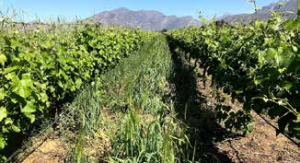 |
| 2 | Rye (Duiker max), Bitter lupins (SSL10) | 40 kg/ha R600/ha | Stand height: Very tall Stand density: Very good Weed suppression:Good |  |
| 3 | Agrilife 2 Stooling rye (Macblue), Oats (Magnifico), Ripper radish (Groundhog), Japanese radish (Nooitgedacht), Common vetch (Timok) | 30 kg/ha R950/ha | Stand height: Tall Stand density: Excellent Weed suppression: Excellent Stooling rye provides more biomass than ordinary rye. The radish and vetch created a dense mat over the work row. | 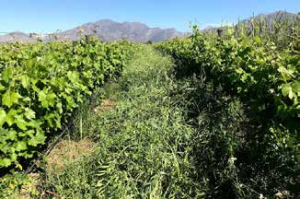 |
| 4 | Mooigezight mix Polymorpha medic (Cavalier), Barrel medic (Paraggio), Subterranean clover (Dalkeith), Balansa clover (Paradana), Bitter lupins (SSL10) | 30 kg/ha R850/ha | Stand height: Medium Stand density: Very good Weed suppression: Fairly good The medics, clover and lupins created provided reasonably effective weed suppression and would be expected to provide good biomass. |  |
| 5 | Goudini mix with triticale Triticale (AG Beacon), Oats (Magnifico), Ripper radish (Groundhog), Japanese radish (Nooitgedacht), White mustard (Braco) | 30 kg/ha R594/ha | Stand height: Very tall Stand density: Very good Weed suppression: Excellent |  |
| 6 | Oats (Magnifico), Peas (Astronaut) | 40 kg/ha R600/ha | Stand height: Medium Stand density: Average Weed suppression: Poor The ryegrass in this row was wide-spread. |  |
| 7 | Hexvallei mix with white mustard Triticale (AG Beacon), Oats (Magnifico), Ripper radish (Groundhog), Japanese radish (Nooitgedacht), Common vetch (Timok), White mustard (Braco) | 30 kg/ha R594/ha | Stand height: Very tall Stand density: Good Weed suppression: Very good |  |
| 8 | Swartland medic mix Polymorpha medic (Cavalier), Barrel medic (Parabinga), Button medic (Bindaroo), Subterranean clover (Dalkeith), Balansa clover (Paradana) | 12 kg/ha R1 200/ha | Stand height: Low Stand density: Very good Weed suppression: Very good The medics and clover mix was quite effective in suppressing weed growth on the bankie, although was not able to entirely outcompete the small mallow (kiesieblaar). |  |
District: Breedekloof
Year: 2019
Demo Site: Klipdrift (Rawsonville)
Soil description: Sandy
Sowing date: Mid-April 2019
At this demo site, forage rye produced considerable biomass and provided good weed suppression. The standard rye was less impressive in terms of biomass and had begun to dry out in late September, which is perhaps an advantage if water resources are limited and a chemical spray is to be avoided. The black (Saia) oats produced excellent biomass but suppressed the bitter lupines to a degree. An increase in the sowing rate of the bitter lupines sowing rate would overcome this. The forage radish also developed well on this soil and produced good above and below-ground growth.
| Treatment | Recommended Sowing Rate kg/ha | Performance* (Biomass production, even development of the stand and weed suppression) | Approximate Seed Cost R/ha | Photos taken |
|---|---|---|---|---|
| Forage rye | 45 | Excellent | 695 | 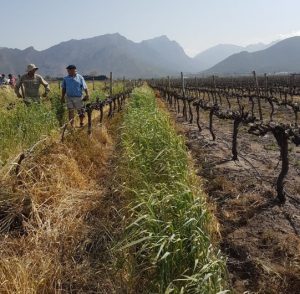 |
| Rye | 55 | Good | 695 | |
| Saia oats + bitter lupines | 25 + 30 | Very good | 590 |  |
| Forage radish + vetch | 2 + 10 | Good/Very good | 600 |
*Performance is an overall indication of the quantity of biomass produced, the development of the stand in terms of even or patchy growth and the degree to which the cover crop suppressed weeds.
District: Breedekloof
Year: 2019
Demo Site: Nuwerus (Rawsonville)
Soil Description: Clay, wet in winter
Sowing Date: Mid-June 2019
The mixture of forage rye and vetch produced average biomass on this soil. The white mustard and forage radish mixture produced a higher biomass compared to the other mixtures.
The forage barley performed better than the forage rye and produced a medium to high biomass. During the winter months, this soil has the tendency to become waterlogged therefore a cover crop with a better tolerance for wet soil conditions such as faba bean would be expected to do well and will be considered for the following . The mixture of medics and clover, which was intended for application on the grapevine row (bankie), performed well despite the somewhat inadequate seeding rate due to its establishment in the work row. The ability of medics, an annual regenerating sward, to re-establish on its own is dependent on various conditions such as water availability, soil chemical and physical conditions and the timing of chemical termination (if required). It is recommended that it be allowed to set seed before termination (if required) and that it be sown for two to three consecutive years on the grapevine row before allowing it to re-establish itself.
| Treatment | Recommended Sowing Rate kg/ha | Performance | Approximate Seed Cost R/ha | Photos taken |
|---|---|---|---|---|
| Forage rye + vetch | 25 + 6 | Average | 650 | |
| White mustard + forage radish | 4 + 2 | Very good | 445 |  |
| Forage barley | 50 | Good/Very good | 450 | |
| Triticale + vetch | 60 + 6 | Good | 615 | |
| Medics (on the bankie) | 5 | Very good | 495 |  |
DISTRICT: WORCESTER
District: Worcester
Year: 2022
Demo Site: Cilmor
Soil Description: Sandy
Vineyard irrigation: Drip
Sowing Date: Middle – Late May
Sowing method: By hand
Harvested: 10 October 2022
Rainfall (2022 vs 4 year average): 257,93mm vs 349,24mm
General climatatic conditions January – September (compared to long term average): January and February had below average rainfall with above average temperatures. March had higher temperatures. May had lower tempratures with above average rainfall. June was warmer than normal but had average rainfall. July, August and September was slightly warmer with below average rainfall.
| Plot | Variety/Species | Type | Seeding rate (kg/ha) | DMP (t/ha) | Observations | Photos taken |
|---|---|---|---|---|---|---|
1 | Barsaia Saia Oats | Cereal | 25 | 2.7 | Looks like seeds had been sprayed before we could harvest. Overall, this mixture did not perform well. Ryegrass was present in the work row. Seed Cost: R776,02/ha | 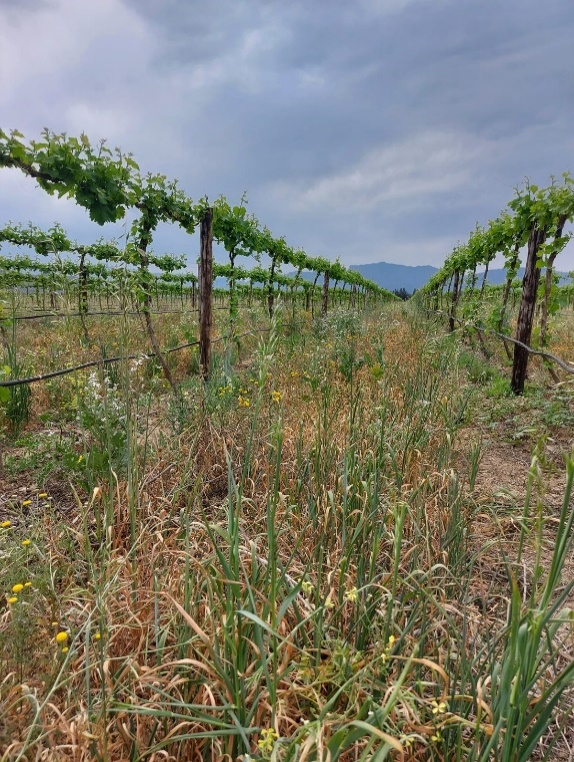 |
Cordoba Radish | Brassica | 1 | 0.1 |
|||
Morava Common Vetch | Legume | 6 | 0.0 |
|||
Total mix | 32 | 2.9 |
||||
"Re-growth"/ "Opslag" | 0.0 |
|||||
Weeds | 0.1 |
|||||
2 | Barforce Silage Barley | Cereals | 30 | 2.6 | Looks like seeds had been sprayed before we could harvest. Overall this mixture did not perform well. Some forage rye came up from the previous season. Ryegrass was present in the work row. Seed Cost: R668,4/ha |  |
Moby Forage Barley | Cereals | 30 |
||||
Total mix | 60 | 2.6 |
||||
"Re-growth"/ "Opslag" | 0.1 |
|||||
Weeds | 0.2 |
|||||
3 | Barpower Forage rye | Cereal | 30 | 4.2 | Forage rye had a good stand and tall growth, past soft dough stage at the time of harvest. White mustard did not perform well. Ramenas was present in the work row at the time of harvest. Seed Cost: R676,84/ha | 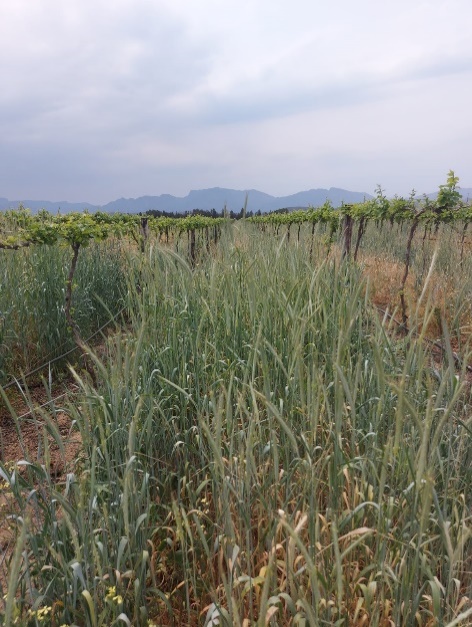 |
Venice White Mustard | Legume | 2 | 0.2 |
|||
Total mix | 32 | 4.4 |
||||
"Re-growth"/ "Opslag" | 0.0 |
|||||
Weeds | 0.3 |
*DM = Dry Matter Production (Tons/Hectare)
District: Worcester
Year: 2021
Demo Site: Cilmor
Soil Description: Sandy
Vineyard irrigation: Drip
Sowing Date: Middle – Late May
Sowing method: By hand
Harvested: Late September 2021
At the Cilmor demo, the bankies were sprayed with herbicide just prior to harvesting the demo plots in late September and some spray drift resulted in a degree of termination of the mixtures. The results of this demo were nevertheless very promising with excellent biomass produced across all three plots, particularly plot 2 and 3.
| Plot | Variety/Species | Type | Seeding rate (kg/ha) | DMP (t/ha) | Observations | Photos taken |
|---|---|---|---|---|---|---|
1 | Barforce Silage Barley Moby Forage Barley | Cereals | 60 | 7.9 | This mixture consisted of two type of barley which provided dense growth and quick coverage to overshadow weeds. Seed Cost: R550/ha |  |
Weeds | 0.0 |
|||||
2 | Barpower Forage rye | Cereal | 35 | 7.3 | This mix of forage rye and white mustard produced an impressive 9.6t/ha of DM and effectively suppressed weeds. Seed Cost: R720/ha |  |
Venice White Mustard | Legume | 2 | 2.3 |
|||
Total mix | 37 | 9.6 |
||||
Weeds | 0.0 |
|||||
3 | Barsaia Saia Oats | Cereal | 25 | 5.2 | The Saia oats was the largest component of the mixture and was not yet in seed at the time of harvesting but still produced 5t/ha DM. This species has a later growing season than other cereals. The fodder radish performed well in this mix and produced 3 t/ha DM however the vetch was suppressed by the other two components. Weed suppression was excellent. Seed Cost: R835/ha |  |
Tajuna Fodder Radish | Brassica | 1 | 3.0 |
|||
Haymaker Grazing Vetch | Legume | 6 | 0.0 |
|||
Total mix | 32 | 8.2 |
||||
Weeds | 0.0 |
*DM = Dry Matter Production (Tons/Hectare)
District: Worcester
Year: 2019
The lack of rain in the Robertson and Worcester region in 2019 created challenging growing conditions, and cover crop growth was largely unsuccessful in these regions.
DISTRICT: ROBERTSON
Year: 2021
Demo Site: De Wetshof
Soil Description: Red Karoo
Vineyard irrigation: Drip (intensive)
Sowing Date: Late May/Early June
Sowing method: By hand
Harvested: Early October
Due to late rains typical of this area, cover crops are often sown fairly late (May/June). The performance of the three mixes sown in the work rows was very good and “kiesieblaar” was scarcely found extending into the rows. The medics on the grapevine row shows excellent potential for a grapevine row cover and living mulch.
| Plot | Variety/Species | Type | Seeding rate (kg/ha) | DMP (t/ha) | Observations | Photos taken |
|---|---|---|---|---|---|---|
1 | Barpower Forage rye | Cereal | 35 | 3.1 | This mixture’s performance was average to good. The forage barley produced a relatively good DM. Weed suppression was relatively good. Seed Cost: R820/ha |  |
Scala Brown Mustard | Brassica | 2 | 0.1 |
|||
Total mix | 37 | 3.2 |
||||
Weeds | 0.2 |
|||||
2 | Moby Forage Barley | Cereal | 40 | 5.3 | This mixture had reached the end of its growth cycle and was flat on the ground when harvested. It produced a very good biomass of over 5 t/h and created a decent mat of material. The Phacelia was outcompeted by the forage barley. Seed Cost: R930/ha |  |
Stala Phacelia | Forb | 3 | 0.0 |
|||
Total mix | 43 | 5.3 |
||||
Weeds | 0.0 |
|||||
3 | Barsaia Saia Oats | Cereal | 25 | 5.9 | This was mixture produced the highest yield at this site, just under 6 t/ha. The oats dominated the mixture and was harvested before its peak weight. The fodder radish and grazing vetch were unsuccessful or outcompeted by the oats. Weed suppression was excellent. Seed Cost: R840/ha |  |
Tajuna Fodder Radish | Brassica | 1 | 0.0 |
|||
Haymaker Grazing Vetch | Legume | 6 | 0.0 |
|||
Total mix | 32 | 5.9 |
||||
Weeds | 0.0 |
|||||
Bankies | Medics | Legume | 5 | 0.7 | The medics sown on the grapevine row successfully suppressed weeds, in particular the ‘kiesieblaar’ (Malva parviflora L.). Seed Cost: R640/ha |  |
*DM = Dry Matter Production (Tons/Hectare)
District: Robertson
Year: 2020
Demo Site: Bo-Langverwacht
Soil Description: Soft Karoo
Vineyard irrigation: Drip
Sowing Date: Middle June
Sowing method: By hand
Late rainfall in the Breedekloof and Robertson areas created extraordinarily challenging growing conditions for most of the cover crop species in these areas, particularly at the site near Bonnievale where the treatments were sown in mid-June. The soil at this demo had to be disked twice before sowing. The performance of the rye and Braco white mustard treatments, however, provided a clear indication that these species ought to be considered where limited and late rainfall is a factor. The Bo-Langverwacht demo also demonstrated that medics and clover on the grapevine row has potential in this area as a weed management tool where irrigation after sowing is possible. Medics should be sown as early as possible and can be boosted with irrigation to promote germination. A well-established medic or medic/clover mix leaves provide an excellent cover of the vine row when growing and beneficial plant residue once it has died off.
| Row | Product mix & species | Recommended sowing rate & seed cost | Comments | Photos taken: Late September 2020 |
|---|---|---|---|---|
| 1 | Goudini mix with barley Barley (SKG 9), Oats (Magnifico), Ripper radish (Groundhog), Japanese radish (Nooitgedacht), White mustard (Braco) | 30 kg/ha R594/ha | Stand height: Low Stand density: Poor Weed suppression: Poor | 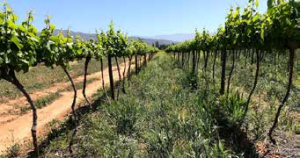 |
| 2 | Hexvallei mix Triticale (AG Beacon), Oats (Magnifico), Ripper radish (Groundhog), Japanese radish (Nooitgedacht), Common vetch (Timok) | 30 kg/ha R594/ha | Stand height: Low Stand density: Poor Weed suppression: Poor Radish performed adequately, but was harvested before the image was captured. |  |
| 3 | Oats (Magnifico), Peas (Astronaut) | 40 kg/ha R600/ha | Stand height: Low to medium Stand density: Poor Weed suppression: Poor |  |
| 4 | Agrilife 2 Stooling rye (Macblue), Oats (Magnifico), Ripper radish (Groundhog), Japanese radish (Nooitgedacht), Common vetch (Timok) | 30 kg/ha R950/ha | Stand height: Low Stand density: Average Weed suppression: Poor The radish and vetch performed better than the rye and oats in this mix. |  |
| 5 | Rye (Duiker max), Bitter lupins (SSL 10) | 40 kg/ha R600/ha | Stand height: Tall Stand density: Good Weed suppression: Good The rye outperformed the lupins in this mix. |  |
| 6 | Oranje Vrystaat Oats (Dunnart), Oats (Magnifico), Stooling rye (Eco) | 40 kg/ha R792/ha | Stand height: Medium Stand density: Average Weed suppression: Average to good | 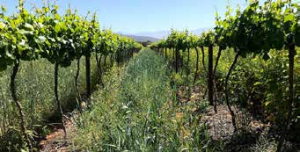 |
| 7 | Braco white mustard | 8 kg/ha R592/ha | Stand height: Very tall Stand density: Good Weed suppression: Excellent Despite the late sowing date and dry, compacted soil conditions, the Braco white mustard was able to develop a remarkably tall, dense stand and effectively suppress the narrow-leaved ribwort (smal weëblaar/tongblaar). |  |
| 8 | Swartland medic mix Polymorpha medic (Cavalier), Barrel medic (Parabinga), Button medic (Bindaroo), Subterranean clover (Dalkeith), Balansa clover (Paradana) | 12 kg/ha R1 200/ha | Stand height: Low Stand density: Poor Weed suppression: Fair to good Seed for this medic/ clover mix was distributed on the grapevine row and did not receive irrigation. |  |
District: Robertson
Year: 2019
The lack of rain in the Robertson and Worcester region in 2019 created challenging growing conditions, and cover crop growth was largely unsuccessful in these regions.
Region: Cape south coast
DISTRICT: ELGIN
District: Elgin
Year: 2022
Demo Site: Paul Cluver Wines
Soil Description: 5-20% clay with 30% gravel
Vineyard irrigation: Micro
Sowing Date: Early May
Sowing method: by hand
Harvested: 3 October 2022
Rainfall (2022 vs 4 year average): 583,6mm vs 646,93mm
General climatatic conditions January – September (compared to long term average): Compared to long term average: January to April had higher temperatures with below average rainfall. May had above average rainfall with lower temperatures. June had higher temperatures but with above average rainfall. July, August and September had average temperatures with below average rainfall.
| Plot | Variety/Species | Type | Seeding rate (kg/ha) | DMP (t/ha) | Observations | Photos taken |
|---|---|---|---|---|---|---|
1 | US 2019 Triticale | Cereal | 60 | 0.0 | The overall mixture did not perform well, phacelia came up but was uneven and growin in patches. Ramenas was prominent in the work row. Cost: R1014,7/ha |  |
Fiesta Faba Beans | Legume | 15 | 0.9 |
|||
| Stala Phacelia | Forb | 1 | 1.1 |
|||
Total mix | 76 | 1.9 |
||||
"Re-growth"/ "Opslag | 0.0 |
|||||
Weeds | 0.9 |
|||||
2 | Barpower Forage rye | Cereal | 30 | 0.9 | Beter weed supression than plot 1, but generally had poor stand. Some radish came up from the previous season. Ramenas was prominent in the work row. Cost: R925,19/ha |  |
Haymaker Grazing Vetch | Legume | 7 | 0.2 |
|||
Total mix | 37 | 1.1 |
||||
"Re-growth"/ "Opslag" | 1.7 |
|||||
Weeds | 0.3 |
|||||
3 | Moby Forage Barley | Cereal | 30 | 0.5 | The mixture did not perform well in supressing weeds and growth was generally very patchy. Radish being the exception produced a good stand and large taproots. Forage rye came up from the previous season. Ramenas and ryegrass was present in the work row. Cost: R762,52/ha |  |
Arvika Forage Peas | Legume | 15 | 0.3 |
|||
Cordoba Radish | Brassica | 1.5 | 1.9 |
|||
Total mix | 46.5 | 2.8 |
||||
"Re-growth"/ "Opslag" | 1.3 |
|||||
Weeds | 0.7 |
|||||
4 | Santiago Medics | Legume | 3 | 0.4 | Dense where the seeds grew successfully. The medics performed beter than the clovers. Overall there were less weeds than on bankies where nothing was sown. Cost: R715,71/ha | 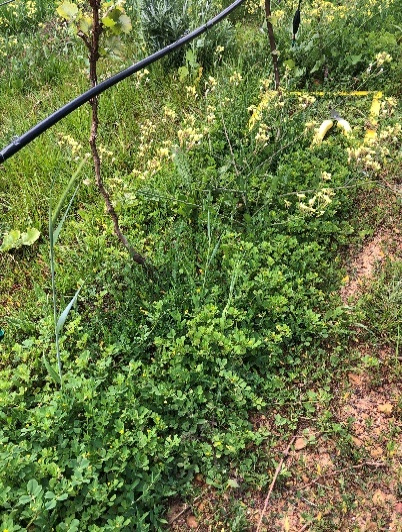 |
Dalkeith Sub. Clover | Legume | 2 | 0.0 |
|||
Total mix | 5 | 0.4 |
||||
"Re-growth"/ "Opslag" | 0.1 |
|||||
Weeds | 0.5 |
*DM = Dry Matter Production (Tons/Hectare)
District: Elgin
Year: 2021
Demo Site: Paul Cluver Wines
Soil Description: 5-20% clay with 30% gravel
Vineyard irrigation: Micro
Sowing Date: Early May
Sowing method: by hand
Harvested: Late October 2021
Although all three mixes performed well at this site, plot 3 with the triticale, faba beans and phacelia, produced the most biomass. Phacelia has been somewhat inconsistent in its performance at various demo sites in previous seasons but is an excellent addition to a mix if aesthetics and insect attraction are prerequisites. In this district, cool soils make cover crop implementation a challenge but the above three mixtures showed good growth and biomass production in 2021.
| Plot | Variety/Species | Type | Seeding rate (kg/ha) | DMP (t/ha) | Observations | Photos taken |
|---|---|---|---|---|---|---|
1 | Barpower Forage rye | Cereal | 35 | 6.6 | Forage rye outperformed the vetch in this mixture and produced a remarkable 6.6t/ha DM. Relatively good weed suppression with only some Ramnas (R. raphanistrum L. ) in the plot. Cost: R965/ha |  |
Haymaker Grazing Vetch | Legume | 7 | 0.7 |
|||
Total mix | 42 | 7.3 |
||||
Weeds | 0.2 |
|||||
2 | Moby Forage Barley | Cereal | 30 | 3.5 | This mixture developed a good stand with the fodder radish creating as much biomass as the forage barley and large taproots. The forage barley performed well despite it being harvested at the end of its growth cycle. The growth of the peas was average to good. Some weed growth was present. Cost: R885/ha |  |
Arvika Forage Peas | Legume | 20 | 0.8 |
|||
Tajuna Fodder Radish | Brassica | 2 | 3.8 |
|||
Total mix | 52 | 8.2 |
||||
Weeds | 0.2 |
|||||
3 | US 2014 Triticale | Cereal | 60 | 7.1 | At 8.5t/ha, this mixture outperformed the others at this site, in terms of DM production. The triticale (US 2014), in its soft-dough stage produced 7 t/ha DM while the phacelia although not a big biomass producer, attracted pollinators and insects. The faba beans were less successful in their growth. “Koperdraad” (knotweed) made up the weed component harvested. Cost: R1395/ha | 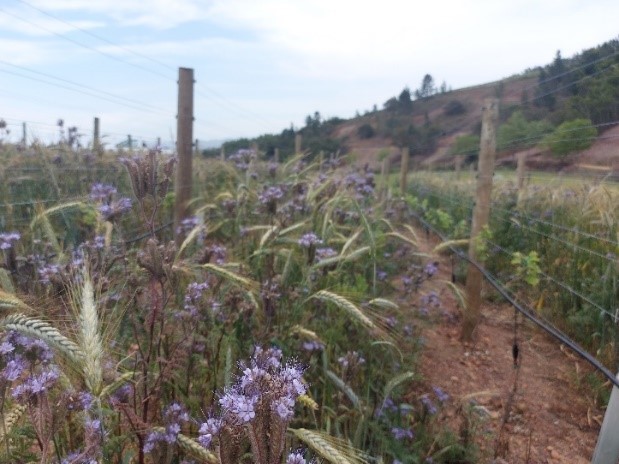 |
Fiesta Faba Beans | Legume | 20 | 0.1 |
|||
| Stala Phacelia | Forb | 2 | 1.3 |
|||
Total mix | 82 | 8.5 |
||||
Weeds | 0.2 |
*DM = Dry Matter Production (Tons/Hectare)
Thank you:

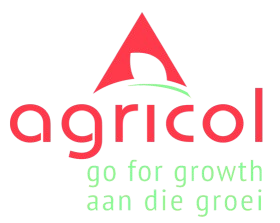

Thank you:





